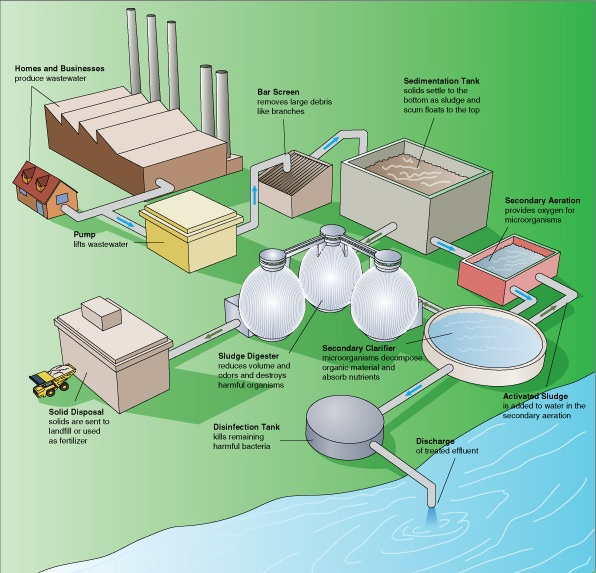The Industrial Internet of Things (IIoT) is creating huge opportunities in the water and wastewater industries, adding value to both the utility and the consumer.
Connected machines are reshaping the way these utilities operate, allowing them to make smarter and more informed decisions. By driving up innovation, water utilities are driving down cost.

Diagram of how a water treatment plant conducts its everyday activity
Relationship between Data and Water Management
Treating water and wastewater requires chemical processes that can now be monitored more accurately using digital data collection.
These digital transformations are taking the guesswork out of chemical processing and allow utilities to optimize a number of chlorine dollars spent to maintain safe levels — saving time, money and empowering operators to make fewer mistakes.
Spurred on by IIOT and Big Data collection, SaaS applications are also implemented which could provide analysis on the wastewater process and accurate calculations on the wastewater clarifier tank performance.
Technologies such as these could also allow businesses to receive alerts and notifications when a failure might arise, predicting when a sludge will overflow and be released.

Real-time data, accessible anywhere, anytime before failure happens.
Problems and Prediction – Pre-empting probable issues
This kind of problem causes environmental issues and fines that can run into millions of dollars. It will also be able to predict a thickening failure, which is when the effluent doesn’t settle correctly and creates a costly sludge blanket in the tank.
Predictive analytics are also solving monitoring problems that were not previously possible for utilities.
For example, there are a large number of pumps that are commonly found within water facilities, and digitized data is making it possible for companies to accurately predict when these pumps might fail — ahead of time.

Even water pumps are fitted with digital technology for data retrieval
It’s similar to the predictive analytic technology used in jet engine checks between airline flights. This cloud-based application easily connects to pumps and helps companies avoid costly and inconvenient failures, allowing engineers to schedule controlled maintenance rather than reactive maintenance.
Partnerships between technology companies and utility companies are facilitating innovation.
Safety procedures are also being monitored and enforced more closely by keeping track of them using digitized technology.
By working closely with our clients, we realize that more informed data could also be used as a reminder to employees regarding protocol procedures when dangerous chlorine leaks are detected. The safety procedure is sent to a worker’s device to be confirmed before access to the contaminated area is granted.
The safety procedure is sent to a worker’s device to be confirmed before access to the contaminated area is granted.

Public swimming pools are at risk of chlorine contamination which would have adverse effects on health.
At Phoenix Contact, we offer industrial platforms that enable asset performance management on an industrial scale. For water utilities, our products can help organize time-series data to monitor asset functionality.

Software and Hardware to manage your Water Management needs
Building close relationships with utility companies would facilitate innovation and allow us to develop solutions to become cleaner and more efficient at a rapid pace.
It truly is a transformative time in the industry, and the results couldn’t be more pure — better drinking water for everyone.
For more information on the products used for water management, visit the link here, or get in touch with us at marketing@phoenixcontact.com.sg.

